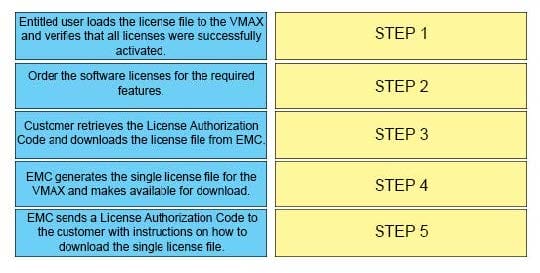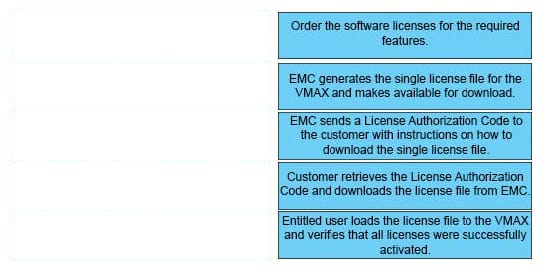E20-307 Online Practice Questions and Answers
DRAG DROP
What is the correct sequence of steps to obtain VMAX licenses and ensure the VMAX is configured to allow these features to work properly?
Select and Place:

When setting the TimeFinder SnapVX time-to-live with the symsnapvx command and parameter –delta 24, what does the –delta parameter specify?
A. Hours
B. Minutes
C. Weeks
D. Days
Which command enables SRDF/A single session consistency protection?
A. symrdf enable consistency
B. symrdf set mode async
C. symcg enable
D. symrdf enable
What is the function of FAST hinting on a VMAX3 array?
A. Sends hints to the array for low access data to be compressed
B. Provides suggestions for manual movement of data to other tiers
C. Provides suggestions for data migration activities to be performed on stale data
D. Sends hints to the array for data that is likely to be accessed in a given period of time
A storage administrator is installing Unisphere for VMAX and noticed there are User IDs listed in the User Authorization database. What must the administrator do to add a default User ID?
A. Create a temporary database and add all User IDs
B. Use SYMCLI to add the default user (smc) to the database
C. Use SYMAPI to add the default user (smc) to the database
D. Use Unisphere for VMAX to remove all User IDs
Which Service Level is available on a VMAX All Flash array?
A. Gold
B. Platinum
C. Diamond
D. Silver
A storage administrator received a request from one of the company's business units to provision a 500 GB volume with a Gold Service Level from VMAX3 array to an existing virtual machine. The administrator leverages Virtual Server
Management from Unisphere for VMAX to provision this volume.
How will the new volume be accessed by the virtual machine?
A. RDM
B. Virtual disk
C. Datastore
D. VVOL
What will happen if one or more source (R1) devices in an SRDF/Synchronous Consistency Group cannot propagate data to their corresponding target (R2) devices?
A. SRDF/S replication will be suspended and a consistent data cleanup will be performed on the R2 targets
B. Data propagation from the specific R1 devices to their corresponding R2 targets will be suspended
C. Data propagation from all R1 devices in the Consistency Group to the R2 targets will be suspended
D. All RDF device pairs in the Consistency Group will be set to Not Ready
In a Unisphere for VMAX remote deployment, Unisphere cannot discover any storage arrays. What could be causing this issue?
A. An FC configuration or SAN issue on or between the Unisphere client and the SYMAPI server may exist.
B. An IP configuration or LAN issue on or between the Unisphere server and the SYMAPI server may exist.
C. Unisphere server is not directly connected to a VMAX3.
D. Unisphere client is not directly connected to a VMAX3.
Which I/O module is used by VMAX3 eNAS systems to facilitate backup to tape?
A. 2-port 10 GbE BaseT
B. 2-port 10 GbE Optical
C. 4-port 8 Gb FC
D. 4-port 16 Gb FC
What does EMC Virtual Storage Integrator for VMware vSphere Web Client require to provision and manage storage from VMAX All Flash and VMAX3 arrays?
A. EMC VMAX Storage Plug-in
B. EMC VSS Provider
C. EMC Unisphere for VMAX
D. EMC SMI-S Provider
After installing Unisphere for VMAX, configuration activities are successfully performed on a VMAX3/VMAX All Flash array. However, performance data is not being collected. What must be done to collect the performance data?
A. Unisphere for VMAX server must be rebooted
B. System must be registered
C. SMAS service must be started
D. PostgreSQL database is corrupt and must be reinstalled
On a VMAX3 array, what is the default Dynamic I/O distribution mode settings when a Storage Group is associated with Host I/O Limits?
A. Never
B. Balanced
C. Always
D. OnFailure
Which VMAX3 point-in-time replication on technology allows snapshots to be created without requiring a target volume?
A. TimeFinder SnapVX
B. ProtectPoint
C. SRDF/Asynchronous
D. Open Replicator
From an application perspective, what should be done prior to performing an SRDF Restore operation?
A. Continue accessing the R1 and R2 devices
B. Continue accessing the R1 devices. Stop accessing the R2 devices
C. Stop accessing the R1 devices. Continue accessing the R2 devices
D. Stop accessing the R1 and R2 devices

